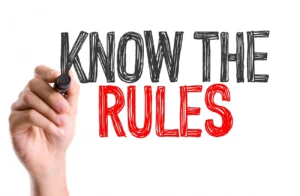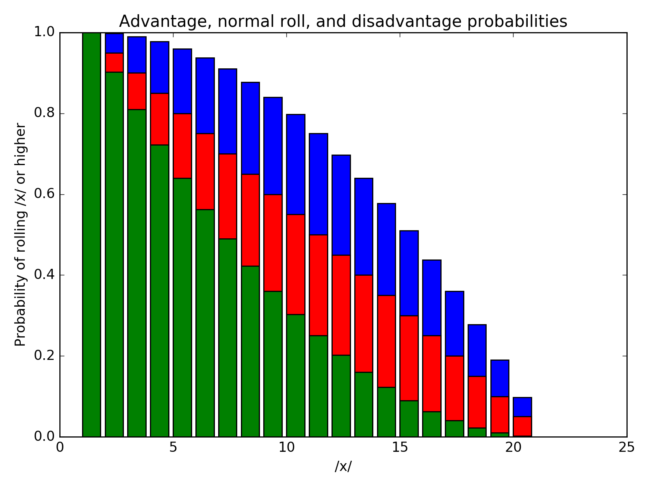 Part of an ongoing series of 5e (2014) Rules notes. This also covers 5.5e (2024) rules.
Part of an ongoing series of 5e (2014) Rules notes. This also covers 5.5e (2024) rules.
One of the 5e design mission statements was to Keep It Simple, Stupid. This KISS principle was a response to the ultra-crunchy tactical game which was 4e. I like miniatures and tactics, so I liked 4e, but it did, by focusing on numbers and formulae so much, drain a lot of color from the game. As I started up my 5e campaign, I constantly found myself running head-smack into things that 4e did that 5e did not, by design, and having to figure out why.
So what is it?
Rather than having players maneuver a blizzard of plusses and minutes on attacks, 5e tries to reduce it down to a simple set of questions for any Attack, Save, or Action Check roll:
- Does the attacker (die roller) have, at the moment, an Advantage over the defender?
- Does the attacker have, at the moment, an Disadvantage, compared to the defender?
Then:
- If there’s no Advantage nor Disadvantage, it’s a Normal attack — roll 1d20.
- If there is both Advantage and Disadvantage, it’s a Normal attack — roll 1d20.
- If there is just Advantage — roll 2d20 and take the higher die roll.
- If there is just Disadvantage — roll 2d20 and take the lower die roll.
Note that (KISS) these are not additive. There is no “Super-Advantage,” and no “Well, you have one Advantage and two Disadvantages, so that comes out to Disadvantage.” There is either just Advantage, or just Disadvantage; otherwise it’s a Normal 1d20 roll.
So what impact does this have?
There are some fancy graphs out there, but Advantage is roughly a +4 on a d20, statistically. Or, as put another way, “Advantage is an enormous benefit that lands 13 or higher 50% of the time, is almost twice as likely to crit, and has 1/20th times as likely to botch.” So 5e doesn’t hand out the status lightly.
Or, put in pictures (please feel free to ignore if math makes you twitchy):

Having Advantage (blue) boosts your numbers up a lot, esp. in the middle range (trying to hit at least an 8-16); having Disadvantage (green) drags your numbers way down.
When do you have Advantage or Disadvantage?
There are a lot of conditions that create Advantage or Disadvantage (since there are very few conditions any more, except cover, that throw numbers, not Ad/Disad). A good survey can be found here:
A few common ones for combat:
- Using the Dodge action during combat has any attack roll against you made at a disadvantage until the start of your next turn (if you can see the attacker). DEX saving throws while Dodging are made with advantage. (Note to GMs: bad guys should Dodge a lot more than they do.)
- Using the Help action during combat can give an ally advantage in one of their own ability checks before the start of your next turn (see “working together”). Alternatively, it can provide advantage on the first of an ally’s attack rolls against a monster.
- Attacking an enemy while hidden (if they don’t detect you approaching) or otherwise unseen grants you advantage on attack rolls. Conversely, attacking an enemy you can’t see has you making the roll with disadvantage.
- Ranged attacks whose target is within a weapon’s long range (but not within normal range) have a disadvantage on the attack roll.
- Ranged attacks (including rolled spell attacks) in close combat (within 5 feet of a hostile creature who can see you and isn’t incapacitated) have a disadvantage on the attack roll. (Spells that require a Saving Throw don’t have this problem because they have no attack roll.)
- Attacks made while prone are at a disadvantage. Attacks at 5′ made on someone who is prone are at an advantage, but attacks beyond that are at a disadvantage.
- You can spend a your point of Inspiration to make an attack, save, or action check at advantage.
Advantage also shows up as a balancer. Kobolds, for example, have a Mob Tactics ability; if a kobold is next to an ally in combat, they each get Advantage on their attack roll. Thugs and Wolves have analogous abilities. That makes them more of a threat than you might think.
How do I roll Ad/Disad?
Normal physical tabletop, just roll two D20s and pick the higher (or lower) one as need be.
The Roll20 VTT standard 5e character sheet provides multiple ways to roll advantage, set through the Settings (gear icon) on the sheet toggle (CORE|BIO|SPELL|cog):
- Advantage Toggle — You’ll see a ADVANTAGE | NORMAL | DISADVANTAGE toggle at the top of the character sheet which you can adjust for each roll. [This is what I do, because I like to be sure I have all my settings right and am not throwing more dice than needed.]
- Advantage Query — For each Attack/Save/Action Check roll, you’ll get as pop up window asking if you have Advantage or Disadvantage. [I find this annoying, myself — though in higher level campaigns it becomes more convenient, given the number of spells, buffs, and situations that impose ADV/DISAD]
- Always Roll Advantage — This will roll 2d20 on everything, then you can apply the roll (higher number for Advantage, lower number for Disadvantage, left-hand number for Normal). [This is a very common way people do this, and for the DM the monsters are all done this way.]
- Never Throw Advantage — Always just roll 1d20; if you need to roll a second die, do it again.
 So how does this change in 5.5e?
So how does this change in 5.5e?
The Advantage/Disadvantage mechanic is the same in 5.5e (2024). This is the most persuasive (though not dispositive) argument that 5.5e is fundamentally the same as 5e.
Most of the changes here are about when ADV/DISAD are used (e.g., when Surprise occurs in a 5.5e game, the Surprised folk roll their Init at Disadvantage).


3 thoughts on “D&D 5e/5.5e Rules – Advantage and Disadvantage!”